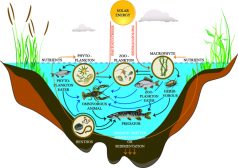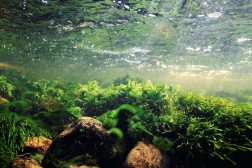Table of Contents
Definition
noun
plural: cytidine monophosphates
(biochemistry) A nucleotide composed of cytosine, ribose and a phosphate group, with a chemical formula: C9H14N3O8P
Details
Overview
A nucleotide is an organic compound made up of three subunits: a nucleobase, a five-carbon sugar, and a phosphate group. The sugar component may either be ribose or deoxyribose. The ribose sugar is the sugar component of the nucleotides that make up RNA. The deoxyribose sugar is the sugar component of DNA. Nucleotides are the monomeric units of nucleic acids. Each phosphate group connects the sugar rings of two adjacent nucleotide monomers. The phosphate groups and the sugar moieties form the backbone of a nucleic acid. The directionality of the chain runs from 5′-end to 3′-end. In DNA, the orientation of the two strands is in opposite directions. This is to allow complementary base pairing between nucleobase constituents. Apart from the long chain of nucleic acids, nucleotides also occur in cyclic forms. Cyclic nucleotides form when the phosphate group is linked twice to the sugar moiety, particularly to the two hydroxyl groups of the constituent sugar.
A nucleotide is, thus, a nucleoside with a phosphate group. Depending on the number of phosphate groups attached to the sugar moiety. It may be called nucleoside monophosphate (if with only one phosphate group), nucleoside diphosphate (with two phosphate groups), or nucleoside triphosphate (when with three phosphate groups).
Depending on the pentose sugar component, a nucleoside may be a ribonucleoside or a deoxyribonucleoside. A ribonucleoside is a nucleoside with a ribose sugar component. Depending on the nucleobase component, the ribonucleoside may be adenosine, guanosine, cytidine, uridine, or 5-methyluridine. A deoxyribonucleoside is a nucleoside with a deoxyribose sugar. Depending on the nucleobase component, a deoxyribonucleoside may be deoxyadenosine, deoxyguanosine, deoxycytidine, thymidine, or deoxyuridine. Also, depending on the nucleobase component, the nucleosides may be grouped into either the “double-ringed” purine or the “single-ringed” pyrimidine.
Structure
Cytidine monophosphate (CMP) is a nucleoside phosphate in being comprised of a ribonucleoside and one phosphate group. It means it has a ribose as its sugar and one phosphate group attached. Its nucleoside contains a pyrimidine base, i.e. cytidine attached to the ribose sugar. It has only one phosphate group attached to the nucleoside.
Common biological reactions
Common biological reactions
CMP may be produced by de novo synthesis pathways. Cytosine, similar to other pyrimidines, is formed from a series of steps, i.e. the formation of carbamoyl phosphate → conversion into carbamoyl aspartate (via aspartate transcarbamylase) → converted into dihydroorotate –> oxidized to produce orotate. 5-phospho-α-D-ribosyl 1-pyrophosphate (PRPP), a ribose phosphate, reacts to orotate to form orotidine-5-monophosphate (OMP). OMP is then converted into other pyrimidines. The enzyme OMP decarboxylase facilitates the decarboxylation of OMP to yield uridine monophosphate (UMP). Phosphorylation of UMP leads to the formation of uridine diphosphate (UDP) and uridine triphosphate (UTP). Amination of UTP leads to the formation of cytidine triphosphate (CTP) by the action of the enzyme CTP synthetase.1 Breaking down of CTP (by losing two phosphates through the action of RNAse) leads to the formation of CMP.
The catabolism of CMP into cytosine ultimately leads to the formation of the by-products β-alanine, NH3 and CO2. The general degradation pathway is as follows: cytosine » uracil » N-carbamoyl- β-alanine » β-alanine, CO2, and ammonia. Nonetheless, cytosine may be recycled via the salvage pathway. For instance, cytosine may be converted into uracil by deamination. By uridine phosphorylase, uracil is converted into uridine by reacting with ribose-1-phosphate. Through the enzyme nucleoside kinase, uridine is converted into UMP.
Biological functions
CMP one of the monomers of RNA. Reduction of CMP produces deoxycytidine monophosphate. CMP may also be phosphorylated (wherein the phosphate group may be donated by ATP or GTP) to produce cytidine diphosphate (CDP) via the enzyme CMP kinase. Further phosphorylation yields cytidine triphosphate (CTP).
As for medical use, CMP is prescribed (together with UMP) for neuromuscular affections in humans.2
Supplementary
Abbreviation(s)
- CMP
IUPAC name
Chemical formula
- C9H14N3O8P
Also called
Derived term
- Cytidine monophosphate n-acetylneuraminic acid
Further reading
See also
- nucleotide
- DNA
- RNA
- cytidine
- deoxycytidine monophosphate (dCMP)
- cyclic cytidine monophosphate (cCMP)
- cytidine diphosphate
- cytidine triphosphate
Reference
- Charma, K. & Somani, D. (2015). Pyrimidine Biosynthesis. Retrieved from Slideshare.net website: ://www.slideshare.net/kskuldeep1995/pyrimidine-biosynthesis-46874172 Link
- Human Metabolome Database: Showing metabocard for Cytidine monophosphate (HMDB0000095). (2019). Retrieved from Hmdb.ca website: ://www.hmdb.ca/metabolites/HMDB0000095 Link
© Biology Online. Content provided and moderated by Biology Online Editors







